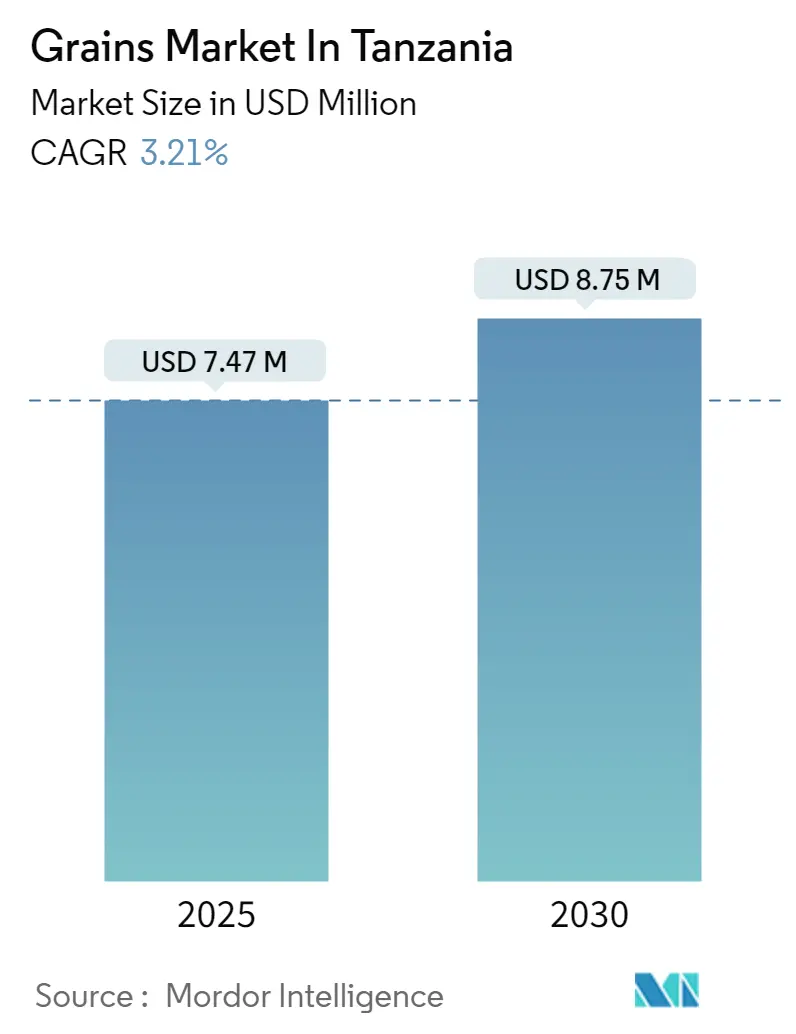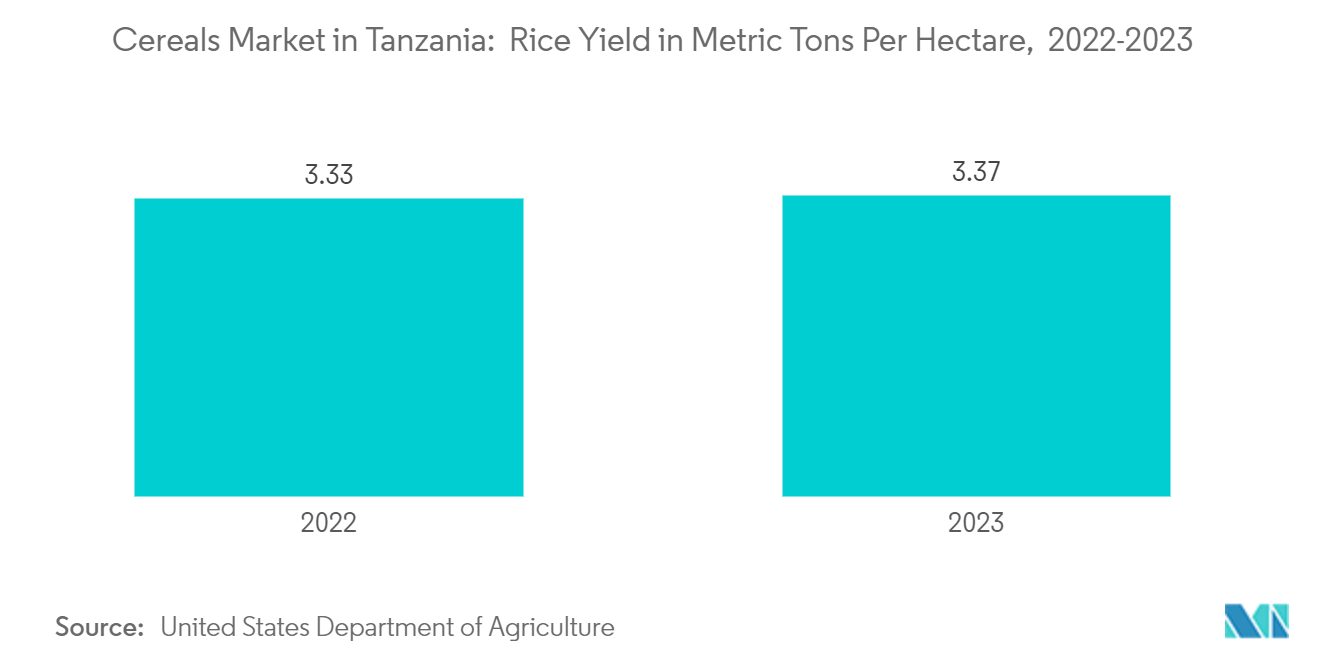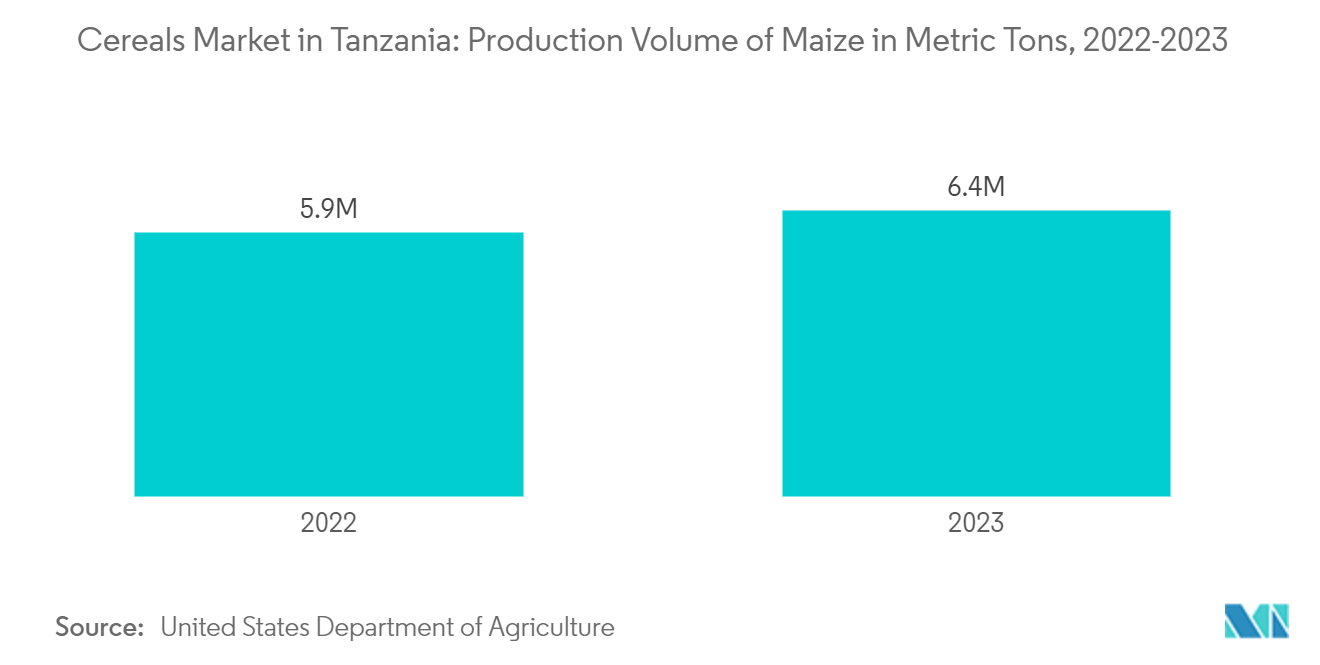Tanzania Cereals Market Analysis
The Grains Market In Tanzania Market size is estimated at USD 7.47 million in 2025, and is expected to reach USD 8.75 million by 2030, at a CAGR of 3.21% during the forecast period (2025-2030).
Cereal production is crucial for food security and poverty alleviation in Tanzania, especially in rural areas where most households depend on agriculture. The primary cereals in Tanzania include maize, rice, sorghum, millet, and wheat. Notably, maize stands out as the country's predominant staple. According to the Food and Agricultural Organization (FAO), maize is the major cultivated cereal in the country with the production volume increased from 5.6 million metric tons in 2019 to 5.9 million metric tons in 2022. Furthermore, rice and sorghum also hold a significant position in Tanzanian agriculture and the country produced 2.8 million metric tons of rice and 1.0 million metric tons of sorghum respectively in 2022.
In Tanzania, cereal crops are predominantly cultivated for domestic consumption. The cereals are rich in carbohydrates, dietary fiber, vitamins, and minerals, and play a pivotal role in the Tanzanian diet. For instance, maize provides essential nutrients like thiamine, niacin, and folate, whereas sorghum boasts high levels of iron and potassium. Tanzanian communities consume a variety of cereals, including maize, sorghum, millet, rice, and wheat, each chosen for its distinct nutritional and culinary attributes. Commonly, these cereal grains are mashed to create thick porridges, and fura, a popular semi-solid cereal meal. Additionally, cereals serve as a primary ingredient of animal feed in Tanzania, with maize being the dominant choice due to its energy content and widespread availability. According to the Food and Agriculture Organization, around 50% of the maize harvested in Tanzania is allocated for animal feed. Thus, the rising consumption and diverse applications of cereals are projected to drive the Tanzanian cereals market in the coming years.
The Tanzanian government has implemented multiple initiatives to boost cereal production, focusing on improving yields, fortifying food security, and reducing reliance on imports. For instance, in April 2024, the government implemented comprehensive strategies to uplift wheat production in the Makete District. These strategies encompass subsidized seeds, modern farming techniques, and advanced irrigation schemes. The overarching goal is to achieve self-sufficiency in wheat, thereby diminishing the nation's significant reliance on wheat imports. To further bolster this initiative, the government has set up two wheat processing plants in Makete district to support the production and to ensure a sustainable wheat processing and distribution framework. These initiatives are part of a broader strategy to modernize cereals production in Tanzania, improve food security, and support the livelihoods of millions of farmers which in turn drives the market growth. However, the threat of climate change, lack of efficient financial support, and extension activities to the small-scale farmers of Tanzania are anticipated to hinderturndrivesthe grain market during the forecast period.
Tanzania Cereals Market Trends
Rising Demand for Animal Feed Accelerating the Cereals Market
Cereals like maize, rice, sorghum, and millet are major ingredients in the production of animal feed. The rising scale of urbanization due to changing consumer preferences in meat products and growing awareness of nutrient management in cattle, sheep, and goats by livestock raisers are projected to boost the demand in the feed market in the coming years. Thus, the demand for cereals such as soybean, wheat, and maize is increasing due to a significant increase in animal feed demand.
Production of crops like maize has significantly increased due to the increasing livestock population, which drives demand for the feed industry. For instance, according to the Food and Agricultural Organization report, in 2022, maize production was 5.9 million metric tons, which increased to 7.0 million metric tons in 2023 in Tanzania. Due to its high energy content, maize serves as a primary ingredient in animal feed, playing a crucial role in formulations for poultry, cattle, and other livestock. Since commercial broiler feed in the country is very expensive and not affordable for small-holder farmers. Maize and protein concentrate traditionally comprise more than 70% of farm-made diets. Which, in turn, is anticipated to boost the cereals market during the forecast period.
In Tanzania, sorghum plays a vital role in animal feed, particularly in arid regions where other crops face challenges. Sorghum is widely grown in regions like Dodoma, Singida, and Shinyanga. It is the third most cultivated cereal in Tanzania, after maize and rice. According to the FAOSTAT, Tanzania's sorghum production reached 1.0 million metric tons in 2023, representing an 11.2% increase over the past five years. Sorghum is rich in energy and provides essential nutrients, making it a valuable ingredient in feed formulations for poultry, cattle, and other livestock. Its higher digestible phosphorus content further diminishes the need for supplemental phosphorus in the feed formulations. Therefore, increasing demand from the animal feed industry is accelerating the production of cereals, which is projected to further fuel the growth of the market studied over the forecast period.
Maize Holds the Significant Position in Production
Maize is one of the staple crops grown in Tanzania, providing over 45.0% of the country's daily calorie consumption. To meet the domestic demand, most farmers grow maize on their farmland. It is one of the largest agricultural commodities in terms of production volume. Maize is also important for poultry feed and a substitute for the brewing industry. Maize is the major cereal grain in the Tanzanian food culture and is utilized in various culinary preparations. For instance, Ugali is the most iconic maize-based dish in Tanzania. It is a dense, polenta-like porridge made from maize flour. It’s a staple food served at almost every meal and is often accompanied by various stews, vegetables, or meats.
In Tanzania, maize is grown in the Iringa, Morogoro, and Ruvuma (southern highlands), Tanga and Arusha (northern highlands), and Kagera (Lake Zone) of the country. According to the United States Department of Agriculture, maize production was 5.9 million metric tons in 2022, which increased to 6.4 million metric tons in 2023. Maize is cultivated in two main seasons such as the bimodal (Vuli) season from October to December and the unimodal (Msumi) season from March to May with harvesting aligning thrice annually to these seasons. Moreover, the government provides training and education to farmers on best agricultural practices, emphasizing the adoption of enhanced maize varieties and sustainable farming methods.
According to the United States Department of Agriculture (USDA), Tanzania's total annual maize consumption in 2023 was 6.3 million metric tons, with white maize being the favored variety. In Tanzania, maize contributes 80% of dietary calories and over 35% of usable protein. Consequently, the rising demand for maize among the population is poised to propel the maize production in Tanzania during the forecast period.
Tanzania Cereals Market News
- August 2024: The National Food Reserve Agency (NFRA) purchased 55,000 metric tons of cereal crops from various traders in its Dar es Salaam-based Kipawa zone. The procurement comprised 20,000 metric tons of paddy and 35,000 metric tons of maize, sourced from large-scale traders and cooperative societies that aggregate produce from farmers.
- June 2023: The Cereals and Other Produce Board of Tanzania invested USD 42.4 million to procure key cereal crops from farmers across the country. This initiative seeks to transform the agricultural scene, especially in cereal cultivation and trade, with a focus on enhancing farmers' incomes.
- July 2022: The African Development Bank Group approved USD 73.5 million to boost food production in Tanzania. The funds strengthen the supply of improved wheat, and rice seeds that are climate resilient, ensure fertilizer availability and affordability, and support policies that enhance the regulatory environment for the rapid uptake of certified seeds and fertilizers.
Tanzania Cereals Industry Segmentation
Cereal crops are small, hard, and edible dry seeds that grow on grass-like plants and are cultivated for their digestible constituents and a botanical structure that comprises the bran, endosperm, and germ. Tanzania Cereals Market is segmented into Types (Maize, Rice, Sorghum, Wheat, and Other Cereals). The study covers Production Analysis (Volume), Consumption Analysis (Value and Volume), Export Analysis (Value and Volume), Import Analysis (Value and Volume), and Price Trend Analysis. The report offers market estimation and forecasts in Value (USD Million) and Volume (Metric Tons).
| Types | Maize | Production Analysis | |
| Consumption Analysis (Value and Volume) | |||
| Import Analysis (Value and Volume) | |||
| Export Analysis (Value and Volume) | |||
| Price Trend Analysis | |||
| Rice | Production Analysis | ||
| Consumption Analysis (Value and Volume) | |||
| Import Analysis (Value and Volume) | |||
| Export Analysis (Value and Volume) | |||
| Price Trend Analysis | |||
| Sorghum | Production Analysis | ||
| Consumption Analysis (Value and Volume) | |||
| Import Analysis (Value and Volume) | |||
| Export Analysis (Value and Volume) | |||
| Price Trend Analysis | |||
| Wheat | Production Analysis | ||
| Consumption Analysis (Value and Volume) | |||
| Import Analysis (Value and Volume) | |||
| Export Analysis (Value and Volume) | |||
| Price Trend Analysis | |||
| Other Cereals | Production Analysis | ||
| Consumption Analysis (Value and Volume) | |||
| Import Analysis (Value and Volume) | |||
| Export Analysis (Value and Volume) | |||
| Price Trend Analysis | |||
Grains Market In Tanzania Market Research Faqs
How big is the Grains Market In Tanzania Market?
The Grains Market In Tanzania Market size is expected to reach USD 7.47 million in 2025 and grow at a CAGR of 3.21% to reach USD 8.75 million by 2030.
What is the current Grains Market In Tanzania Market size?
In 2025, the Grains Market In Tanzania Market size is expected to reach USD 7.47 million.
What years does this Grains Market In Tanzania Market cover, and what was the market size in 2024?
In 2024, the Grains Market In Tanzania Market size was estimated at USD 7.23 million. The report covers the Grains Market In Tanzania Market historical market size for years: 2019, 2020, 2021, 2022, 2023 and 2024. The report also forecasts the Grains Market In Tanzania Market size for years: 2025, 2026, 2027, 2028, 2029 and 2030.
Our Best Selling Reports
Grains Market In Tanzania Industry Report
Statistics for the 2025 Grains In Tanzania market share, size and revenue growth rate, created by Mordor Intelligence™ Industry Reports. Grains In Tanzania analysis includes a market forecast outlook for 2025 to 2030 and historical overview. Get a sample of this industry analysis as a free report PDF download.





